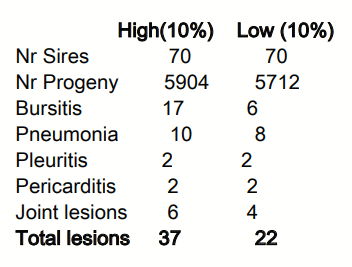Inclusion of slaughter line lesions in breeding values for better animal welfare
Published: July 19, 2023
By: M. Martens 1, E. Willems 1, M. Olde Monnikhof 1, P. Mathur 2 / 1 S&D, Topigs Norsvin, Helvoirt; 2Topigs Norsvin Research Centre, Topigs Norsvin, Beuningen, Netherlands.
Summary
Keywords: Genetic Resistance, Slaughterhouse, welfare
Introduction:
Slaughter line observations can be included in breeding values of breeding pigs to enhance animal welfare. By monitoring lesions/remarks on joints, lungs, hearts and other parts of the carcasses, clear differences between farms and individual pigs can be demonstrated. Lesions like bursitis, pericarditis and pneumonia indicate lower welfare of the animals. Higher incidences of these lesions are associated with lower average daily gain. These lesions are quite heritable (bursitis 15%, pneumonia 6%, pleuritis 12%, pericarditis 19%, joint lesions 17%). So genetic selection can be expected to reduce these lesions in the progeny.
Materials and Methods:
Data from a large meat packer in Germany collected between July 2011 and September 2014 from 90024 pigs were used. The data showed the following average incidences of lesions/remarks
Pneumonia 12.2%
Bursitis 12.1%
Joint lesions 4.6 %
Pleuritis 3.1%
Pericarditis 2.4%
Results:
There are clear differences of lesion/remarks between farms. Farms with lower welfare considerations have a higher incidence of lesions and lower average daily gain. Male pigs showed a higher incidence of lesions than female pigs. Carcasweight however was not influenced by the lesions.The boars were split into two classes based on their breeding values for high and low incidence of remarks. The incidences of different lesions in their progeny were as follows;

The observations in the progeny also showed a clear relation with several breeding value classes (graph will be shown at congress).
In view if these favorable results, breeding values for bursitis, pneumonia, pleuritis and pericarditis were combined into an index based on their respective economic values for calculation of the welfare index (TWI) for each pig.
Conclusion:
These data show that slaughterhouse observations can be used to include in breeding values (TWI). A large database of individual slaughter lesions is needed. So far this was only carried out in Germany.
Boars with a high TWI are expected to have progeny with fewer remarks when slaughtered and monitored.
This has a benefit in welfare for the animals as they suffer less from leg and joint disorders next to pneumonia and pericarditis. The incidence of these lesions is associated with a lower profit. So the TWI inclusion will also lead to a better economic result for producers and contribute to better welfare for the entire pork value chain.
Disclosure of Interest: None Declared.
Published in the proceedings of the International Pig Veterinary Society Congress – IPVS2016. For information on the event, past and future editions, check out https://ipvs2024.com/.
Content from the event:
Related topics:
Recommend
Comment
Share

Would you like to discuss another topic? Create a new post to engage with experts in the community.





.jpg&w=3840&q=75)